Exclusive: Environmental authority explains how China has handled medical waste amid mass COVID-19 nucleic acid tests to avoid damage to the environment

Staff members dispose medical waste outside a PCR (polymerase chain reaction) lab for nucleic acid testing in Xianyou County, southeast China's Fujian Province, Sept. 14, 2021. Three PCR labs have been built in the county to boost nucleic acid detection capacity.Photo:Xinhua
China is fully able to process the medical waste generated by the COVID-19 nucleic acid tests in the country. The amount of waste has become a concern, and even an excuse for some Western media to criticize the country's anti-virus policies. Moreover, China's system of handling the waste has gained approval from international authorities, who have even introduced the experience to other countries.
Some foreign media outlets recently alleged that protective suits, cotton swabs and test kits used in normalized nucleic acid testing for COVID-19 under China's dynamic zero-COVID policy might create an increased environmental burden. "China's COVID mass-testing mantra is building a waste mountain," NDTV claimed.
However, it has been proved that cities in China have established a relatively complete and standardized medical waste collection, transportation and disposal system, and the medical waste in remote areas can basically be covered as well, the Global Times on Monday learnt from the Department of Solid Wastes and Chemicals under the Ministry of Ecology and Environment (MEE), which stated China's medical waste disposal system in detail during the epidemic.
Nucleic acid testing includes multiple links such as sampling, transporting, testing and reporting. Solid waste is generated in all links, such as discarded swabs, packaging, masks and protective clothing, which have certain infectious risks. The waste has been sorted and managed according to the sources and attributes.
The waste generated by the nucleic acid testing institutes, including medical institutes, disease control institutions and third-party medical testing laboratories, are disposed of as medical waste. For the waste from antigen tests, which are used by medical and health institutes, isolated personnel and community residents, if it is related to positive cases, it will also be disposed of as medical waste. Otherwise it will be managed as domestic refuse.
Every 1 million people generate about five tons of nucleic acid testing waste, the Global Times learnt from the MEE.
Nucleic acid testing is an important means of epidemic prevention and control at this stage, and China has sufficient capacity to dispose of nucleic acid testing waste.
Since the outbreak of the COVID-19 epidemic in 2020, the National Development and Reform Commission, the National Health Commission, the Ministry of Ecology and Environment (MEE) and other governmental departments have successively issued several regulations to guide and urge local governments to establish centralized medical waste disposal facilities.
By the end of 2021, China had 540 centralized medical waste disposal units, which could dispose of 2.15 million tons of medical waste annually, a 39 percent rise compared with 2019. Local regions also have the capability to respond to emergency situations.
In general, the country's medical waste disposal capacity is sufficient to meet the needs of various kinds of medical waste disposal, including nucleic acid testing waste. Since the COVID-19 epidemic, all the medical waste has been disposed of properly.
China produced 1.18 million tons of medical waste in 2019, with the waste disposal capacity that year standing at 1.54 million tons. In 2021, the medical waste generated in China reached 1.4 million tons.
After the COVID-19 epidemic outbreak in 2020, the MEE issued several documents to enhance environmental supervision and service measures.
In the same year, the ministry released a pollution control standard on medical waste disposal, which regulates the emission concentration limits of dioxins and heavy metals in flue gas of medical waste incineration.
China's medical waste disposal has followed the standard, and the environmental risks are generally controllable.
In the past five months, the average daily load rate of medical waste disposal facilities in cities, prefectures and municipalities involving medium- and high-risk areas across the country has been lower than 90 percent.
For instance, during the latest round of the epidemic in Shanghai this year, the peak amount of medical waste generated reached 1,420 tons per day. Under the instructions of the MEE, the daily disposal capacity of 404 tons was gradually increased to 1,585 tons per day. From March 1 to July 30, all 108,000 tons of medical waste generated in Shanghai was properly disposed of.
Under the supervision and control of health, environment, transportation and urban management departments, the nucleic acid testing waste has been properly disposed of and the risks are controllable.
As early as in 2004, a project between China's then Ministry of Environment Protection and the United Nations Industrial Development Organization (UNIDO) on sustainable medical waste management was approved. It has promoted the reduction and detoxification process of medical waste in China, leading to about 40 policies, regulations, standards and instruments, according to the MEE.
During the COVID-19 epidemic, the UNIDO also assisted with medical waste disposal and showed appreciation for the achievements by China's medical waste management and disposal work in the process of epidemic prevention and control.
Based on the work experience during the epidemic in China, the UNIDO produced a medical waste emergency management training film, which has been publicly released on its official social media.
China has also been sharing its experience gained during the medical waste disposal. On June 24, 2020, the Basel Convention Regional Centre for Asia and the Pacific published the Handbook of Emergency Disposal and Management of Medical Waste in China to the 187 contracting parties around the world.
Through the United Nations Development Program, China's experience confronting COVID-19 has also been helpful for medical waste management in Laos, the Philippines, Myanmar, Cambodia and Nepal.




